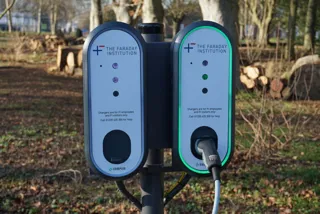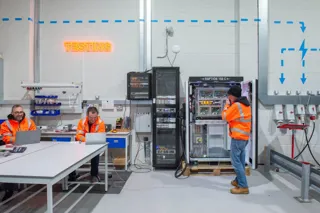By Vidal Bharath, chief commercial officer at Bramble Energy
Mobility-centred industries are the engines of the global economy, enabling trillions of dollars of trade every year.
Yet sector players are now gearing up for what is perhaps the most significant period of disruption in their history.
Pressing net zero targets are powering an automotive evolution.
In 2019, the UK transport sector accounted for almost 27% of total national emissions, with 91% of this stemming from road-based operations.
Decarbonising transport is therefore imperative if the UK’s national target of net zero emissions by 2050 is to be met.
Thankfully the UK government appears to be taking this seriously.
It has committed to all central government cars and vans (approximately 400,000 vehicles) being fully zero emission by 2027.
Further, the national transportation framework for a clean transition outlines the end of the sale of new petrol and diesel cars and vans by 2030, and phase out of non-zero emissions heavy goods vehicle (HGV) fleets come 2040.
Companies are attempting to follow suit, having committed to switching over 700,000 vehicles to zero emissions by 2030.
For firms, switching to zero emissions vehicles (ZEVs) can generate substantial cost and emission savings.
Indeed, Transport & Environment (T&E) reveals that battery electric cars in Europe currently emit three times less CO2 than equivalent petrol or diesel cars, while hydrogen combustion engines provide a zero-emissions option for specific use cases.
Innovation is on its way…
There are several climate technologies making headway to automotive players to support these ambitions, from batteries to fuel cells to biofuels.
However, despite both the need for and benefits of greener transport solutions, many industry professionals are still grappling for answers when it comes to achieving a goal that appears to be so far out of reach.
The ‘why’ is clear, but the ‘how’ is still missing for many, with enterprises of the view that several barriers need to be overcome before these solutions become realistic and attainable on a broad basis.
In a Bridgestone and Webfleet survey of 300 fleet operators, 62% said more government involvement is required to make transportation cleaner, while 60% stated that there needs to be more business collaboration.
Further, the report reveals that half of fleet managers believe that competing interests are adversely impacting sustainability targets and contributing to a lack of concrete transition strategies and investment.
Perhaps unsurprisingly, concerns were also shared over technology, with almost a third of heavy fleets and four-in-10 van operators of the belief that the technology is currently insufficient.
Common reservations around the efficiency of hydrogen-powered cars remain, for example, and there are equally poor perceptions on infrastructure.
Indeed, the survey reveals that 41% pointed to the lack of rapid charging infrastructure as a major hurdle in the case of EVs.
Taking small, immediate steps is key
According to McKinsey, some $3.5 trillion needs to be spent on low-emission vehicles and charging and fuelling infrastructure per year on a global level between 2021 and 2050 to make net zero targets attainable – monumental figures that can understandably feel simply unattainable.
However, while the big picture might look overwhelming, mobility firms are beginning to take smaller, more manageable steps in furthering their sustainability agendas.
If we can look at our net zero challenges through ‘transition over time’ goggles, rather than goals to hit in one go, we have the opportunity to find different, achievable solutions.
The key is to break the bigger ambitions down into bite-sized targets. Here, a multi-pronged approach will be supportive.
It’s not just about investing in greener tech, but equally taking a more holistic view and aiming to find places for improvement throughout the value chain.
Optimising routes and reducing vehicle movements among fleet networks is one avenue capable of both reducing costs and carbon footprints, for example.
Further, thinking strategically about future fleet requirements now will help to make the transition process smoother in three to five years’ time, ensuring operational needs are met and benefits maximised.
As an example, fleet managers should work to determine potential on-site charging requirements.
In the case of EVs, while many low-cost 3.7kW to 7.4kW charging points are likely to be sufficient for overnight charging, higher capacity stations may be needed for larger vehicles that rack up higher daily mileage averages.
Equally, hydrogen fuel cells currently deliver longer ranges and quicker refuel times than battery-powered HGVs, and so these may make more sense for industry players.
It is vital to improve understanding in order to identify the best solutions and support available.
That includes becoming more familiar and aware of funding schemes available, such as the UK government’s Workplace Charging Scheme (WCS) that contributes three quarters (75%) of the purchase and installation costs of electric charging points up to 22kW.
Equally, ZEVs – be it EVs, hydrogen-powered, or otherwise – are still somewhat alien to many people, engaging with drivers will also be important.
Here, educational initiatives might include regular communications that explain why such vehicles are needed, or the organisation of vehicle test drives.
Short term steps towards a wider goal
Of course, establishing new supply chains and manufacturing capabilities to decarbonise the mobility sector will take time.
Getting the right infrastructure in place and making sure the funds are available to undertake such projects is no simple task.
Further, many companies throughout the mobility system will face transition risks – be it OEMs, suppliers, manufacturers, or operators of critical infrastructure.
However, by gradually introducing structural and cultural changes to support the technological transition, the uptake of zero emission vehicles can be accelerated, accepted and achieved in a more manageable manner, bit by bit.
> Interested in comparing electric vehicle data? Check out our EV tool.
> Interested in ensuring the efficient use of EVs. Check out our dedicated editorial sections: Insight & policy | EV news | Charging & infrastructure | Costs & incentives | Benefit-in-kind | EV case studies | EV road tests





















Login to comment
Comments
No comments have been made yet.